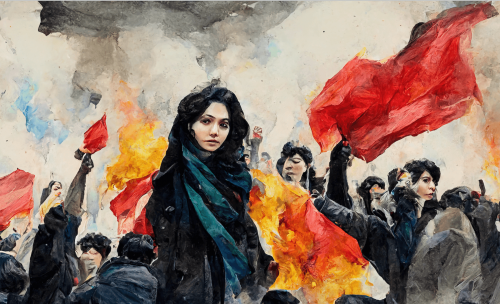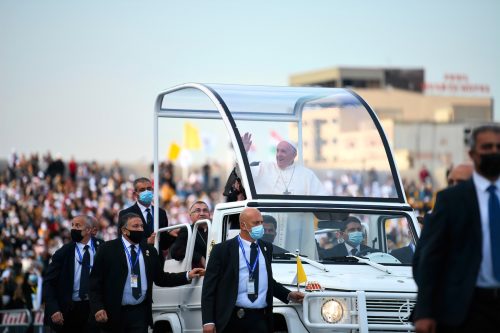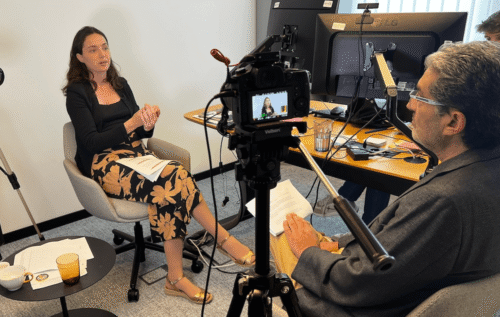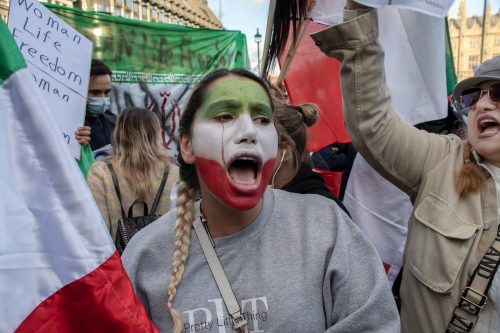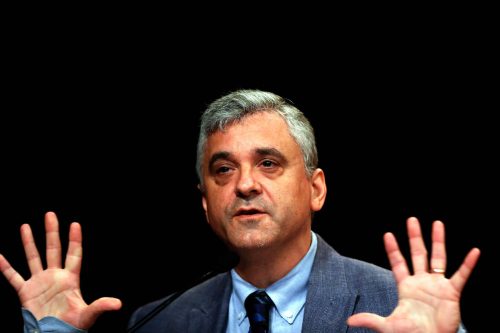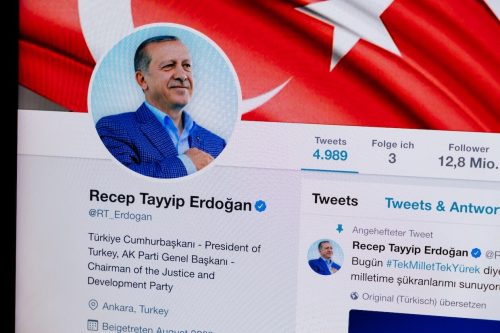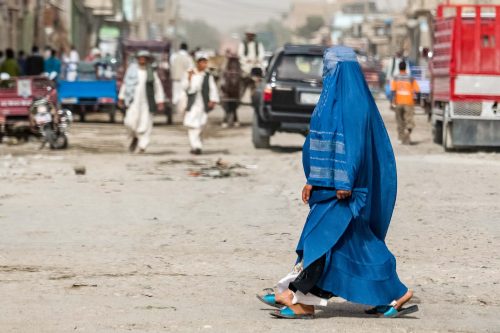Iran

Iran has two main threads of populism: religious and nationalist. Populists called upon a shared Muslim heritage, but they also appeal to nationalism, referencing the glorious Persian past. Populists in Iran glorify the “ordinary people as the essence of the national identity,” while stigmatizing anti-nationalism, economic elites, and foreign imperialism.
Located in the Middle East, Iran has a unique theocratic government system established after the fall of Shah Mohammad Reza Pahlavi’s monarchical rule in 1979. The deteriorating social, economic, and political situation during the final years of the Shah’s regime allowed opposition groups to consolidate against the government. Ayatollah Khomeini, due to his broad religious base, emerged as the main opposition, consolidating support from other opponents of the Shah. Through his clerical force, Khomeini established a theocratic government which was framed according to the Wilayat al-Faqih doctrine. Although the Shiite understanding of Islam has dominated Iran’s social, political, and economic policies, the country’s rich civilizational past has been considered as an essential reference, to which the new regime’s officials have often called upon.
Because Iran’s political system combines elements of presidential democracy and an Islamic theocracy led by an autocratic Supreme Leader, authoritarianism represses fundamental rights. Iran scores poorly in global indexes when it comes to corruption, transparency, and problems with ethnic and religious minority groups (Freedom House, Economic Intelligence Unit, and RSF).
There have been several scholarly efforts at explaining the populist manifestations of Iran’s Islamic Revolution (Dorraj & Dodson, 2009; Moghadam, 1994), as well as the social, economic, and political atmosphere during and after the revolution. Populism in Iran could be regarded as solely a product of the Islamic Revolution (Alamdari, 2005). The revolution gained its legitimacy by grounding its cause in the dominant Shiite Islam, specifically the context of Khomeini’s interpretation of it. Many of the revolutionary ideals were populist (Algar 1980). Ayatollah Khomeini proclaimed that the Islamic Revolution stood for the “disposed” and “oppressed” people against the traditional elites (Halliday, 1982; Alamdari, 1999).
In the Iranian context, populism can be seen as a non-class structure of charismatic leadership that primarily utilizes religion to exploit a populace hungry for salvation (Alamdari, 2005). The Shah tried to use populism to his advantage, too. The land reform of 1961, for instance, aimed to replace Iran’s agrarian economy with a more traditionally western, capitalist economy. It was sold to the people using populist rhetoric, though its aim was to neutralize any revolutionary sentiments among the peasants. Ultimately, the land reform resulted in peasants pouring into Iran’s cities, changing their demographics through unregulated social mobility and economic stratification, which paved the way for Khomeini’s revolutionary populism (Alamdari, 2005).
This revolutionary populist spirit reflects the ideological composition of the movement that overthrew the Shah’s rule (Bakhash, 1989). When nationalist and religious ideological leaders encouraged regime officials to label opposition groups “traitors” and “infidels,” this paved the way for eliminating threats after the Shah’s overthrow. Populist rhetoric has been used to justify confiscating the property of those who fled the country and the nationalization of major industries, including many financial companies and undeveloped land (mawat) (Bakhash, 1989).
Referencing only the religious side of populism in Iran (Afrachteh, 1981) might be misleading because nationalist appeals that make reference to a glorious Persian past are essential to Iranian populism. Ansari (2008) states that religion, and society’s responsiveness to it, as well as this shared Persian past played a significant role in utilizing populist rhetoric while developing the revolutionary program.
The irony of this is that Reza Shah used his own populist tact when ascending to power. He portrayed himself as the country’s savior, an authentic Iranian hero framed within a monarchical tradition as well as a Zoroastrian one (Shafaq, 1952). His son, Mohammad Reza Shah, linked divine monarchy with Iranian monarchical tradition and Shiite Islam (Ansari, 2008). Ayatollah Khomeini and the Islamic revolutionaries would use similar populism against the Shah (Halliday, 1982).
The main elements of Khomeini’s political thought consisted of “radical anti-imperialism,” “Shiite populism,” and Islamic government under the clerical rule, which he expounded on under the title of the Wilayat al-Faqih perspective(Ostovar, 2016). This political view enabled him to gain immense support from Islamist guerrilla movements, enthusiastic clergy, and other revolutionary leaders. Describing vali-ye faqih as the one acting as a substitute for the Hidden Imam (based on the understanding of 12 Imam Shi’ism), allowed revolutionary elites to call for the Hidden Imam’s return. This messianic perspective also manifested itself during Mahmood Ahmadinejad’s presidency, from 2005-2013. Representing the “ordinary people,” Ahmadinejad called for a “return to the revolutionary ideals,” by emphasizing the fallacies of reformist policies during the Khatami era (Dorraj, 2014).
Ahmadinejad’s populism worked well: he helped the regime reconcile its contradictions by praising the founding credentials of the Islamic Revolution. By promising a “utopian future,” as a presidential figure, he has motivated to empower the resistance of the Achilles heels of the Islamic Republic. This “savior complex” is common in Iranian politics, which often combines such utopian beliefs with its theocratic ideology (Ansari, 2008). By presenting the Islamic Revolution as the ultimate reference point, Ahmadinejad took his country back to the radical populist policies of the early days of the revolution (Dorraj & Dodson, 2009). Such populist narratives have become a vanguard of the Republican Guard in its efforts to clear “reformist debris” (Ostovar, 2016).
Populists in Iran glorify the ordinary people as the essence of national identity while stigmatizing the anti-nationalist, cultural and economic elite and foreign imperialists. Identity formation in revolutionary Iran, to a great extent, was shaped through this logic. It also played a critical role in Ahmadinejad’s presidential terms. Before the elections in 2005, Ahmadinejad underlined the issues which were most attractive to the despondent masses (Raisi 2019).
Condemning the privileged clerical elite as “corrupt,” Ahmadinejad described “the pure people” as being isolated from the benefits of the whole country. Ahmadinejad criticized the Khatami administration as being “unjust” in terms of economic management and development. He proposed “bringing oil money to people’s dinner tables,” which became one of his slogans (Ghiabi & Habibi 2014). A former guardsman and sincere advocate of Iraq war veterans, Ahmadinejad attracted great support from Basij militias; the IRGC (Islamic Republic Guard Corps) had one of his former members at the presidential office throughout his terms (Ostovar, 2016). Support from the Supreme Leader, IRGC, and Basij provided significant leverage to pursue populist policies.
Religious references remained the major form of populist discourse in the political, cultural, and economic spheres. Temporary marriage, for instance, was presented as a sign of a progressive worldview by Rafsanjani (Niechcial, 2009). Meanwhile, Iran’s regional aspirations provided another opportunity. By exporting the regime’s policy, Shiism became even more influential in the political sphere (Emadi, 1995).
To ease any reactionary movements, Iran initiated the “Taqrib al-Madhahib” program, which aimed to reproach Sunni and Shiite sects (Kaplan, 2014). Taqrib was an effort to explain the “good conditions and freedom” of the Sunni minority in Iran and the “non-sectarian ummah” of Iran to Sunni countries and peoples. Iranian Baluch, Turkmen, and Kurdish scholars were important figures at the Taqrib meetings (Büyükkara, 2016). Nevertheless, the discourse of “ummah unity” (Algar, 1981) has not been convincing to Sunni Muslims and states due to Iran’s increasing Shia expansionism and its military, political, and economic relations with other Shiite groups in the Middle East. However, the Taqrib council continues its activities. The belief that the institutional entity represents the official view has become an established view among the Supreme Leadership.
In cases where national interests and Islamic principles coincide, achieving legitimacy in the eyes of the public and opposition again rests with religious rhetoric (Dogru, 2018). The Umm al-Qora doctrine put forward by then-Deputy Foreign Minister Mohammad Javad Larijani provided a practical solution to following a course of action when Islamic interests in foreign policy conflicted with the national interest.
Given that Iran’s regional aspirations, support for Shiite militias across the region, and nuclear proliferation remain at the top of the regime’s agenda, populism – as advanced through religious and nationalist rhetoric – will have a significant role to play in Iran during the coming years. As long as the regime is eager to guard its basic founding elements, populism will leave its trace on Iran’s social, political and economic policies.
By Ahmet Dogru
December 22, 2020.
References
— (2014). “Doktorin-e Omm al-Qari.” Pajoohe: Bozorgterin Bank-e Makalat-e Êlm-e İnsani ve Islam.
Abrahamian, A. (1993). Khomeinism: Essays on the Islamic Republic. Berkeley: University of California Press.
Algar, H. (1980). Constitution of the Islamic Republic of Iran, Berkeley: Mizan.
Algar, H. (1981). Islam and Revolution; Writings and Declarations of Imam Khomeini, London
Bakhash, S. (1989). “The Politics of Land, Law, and Social Justice in Iran.” Middle East Journal. 43, 186-201.
Büyükkara, M. A. (2016). “İran’ın Takribi Mezahip Politiği.” Ortadoğu Analiz. 8 (74). 22-24.
Dogru, A. (2018). Kurdish Issue in the Post-Cold War Iranian Foreign Policy within the Framework of Securitization Theory and World-System Approach. PhD Thesis. Ankara: Gazi Univeristy.
Dorraj, M. and Dodson, M. (2009). “Neo-Populism in Comparative Perspectives: Iran and Venezuela.” Comparative Studies of South Asia, Africa and the Middle East, 29 (1), doi 10.1215/1089201x-2008-049
Emadi, A. (Kasım, 2014). “Doktorin-e Omm al-Qari.” Pajoohe: Bozorgterin Bank-e Makalat-e Êlm-e İnsani ve İslam. http://pajoohe.ir/a-45075.aspx (accessed on April 12, 2020).
Emadi, H. (1995). “Exporting Iran’s Revolution: The Radicalization of the Shiite Movement in Afghanistan.” Middle Eastern Studies. 31(1), 1-12. http://www.jstor.org/stable/4283695 (accessed on December 7, 2020).
Ghiabi, M & Habibi, N. (2014). “Tumbling oil prices a challenge to Iranian economy as it tries to come in from the cold”The Conversation, https://theconversation.com/tumbling-oil-prices-a-challenge-to-iranian-economy-as-it-tries-to-come-in-from-the-cold-33518, (accessed on June 12, 2020).
Kaplan, D. (2014). “İran’da Şii-Sünni Yakınlaştırma Çalışmaları.” In: Mesut Okumuş, Cemil Hakyemez, (eds). Ortadoğu’nun Geleceği Açısından Şii- Sünni İlişkileri. Çorum Belediyesi Kültür Yayınları. Çorum, pp 165-176.
Kurzman, C. (2004). The Unthinkable Revolution in Iran. Cambridge: Harvard University Press.
Larijani, M. C. (1990). Magolat-i Stratejiy-i Melleyi, Tahran: Merkezî Com ve Neşir-i Kitab.
Moghadam, V. (1994). “Islamic Populism, Class, and Gender in Post- revolutionary Iran.” In: A Century of Revolution: Social Movements in Iran. Ed. John Foran. Minneapolis: University of Minnesota Press.
Nadiri, A. (2015). “Şii Devlet Rasyonelleşmesinin Teorik Çerçevesi.” Dünya Bülteni. Nisan. http://www.dunyabulteni.net/dubam/326357/sii-devlet-rasyonellesmesinin-teorik-cercevesi, (accessed on December 7, 2020).
Ostovar, A. (2016). Vanguard of the Imam. New York: Oxford University Press.


